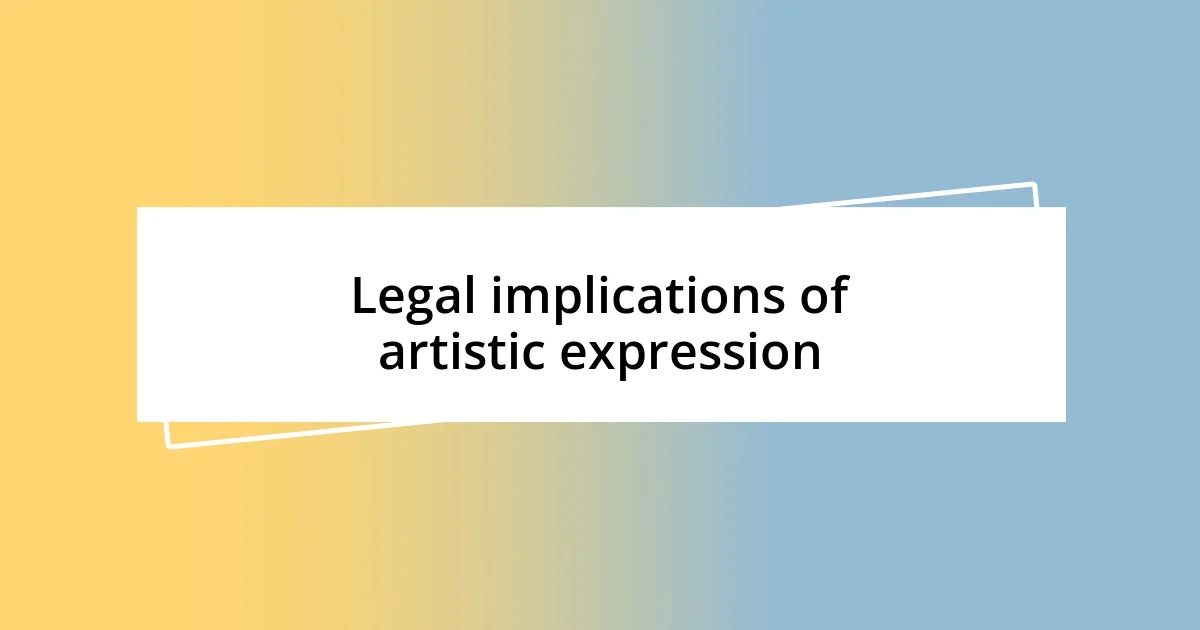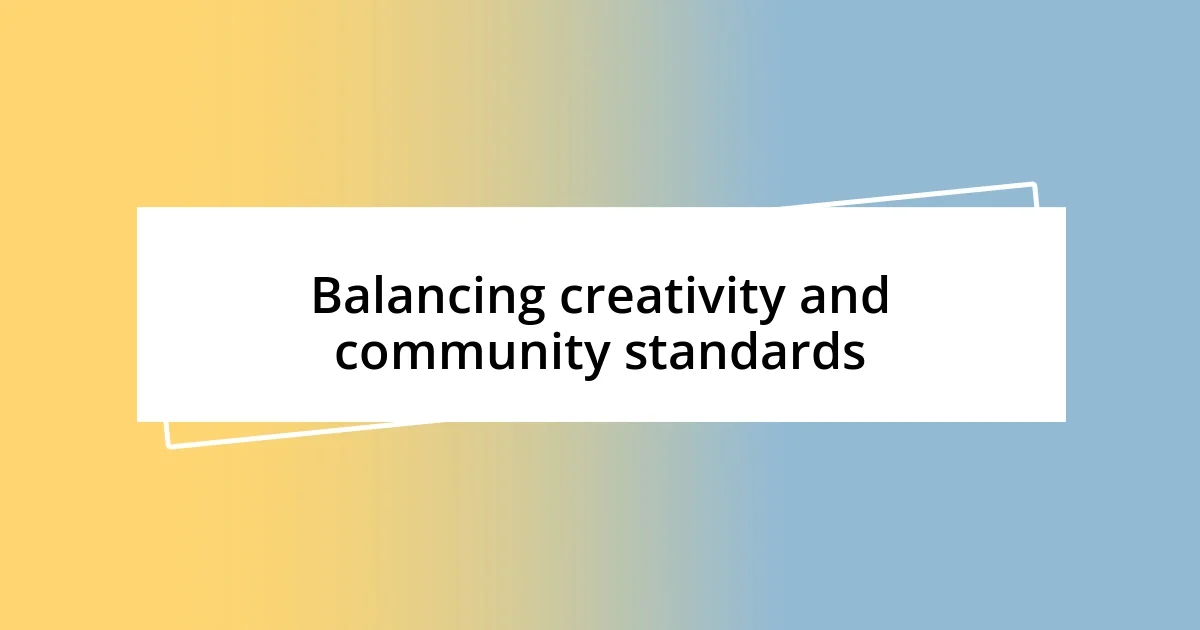Key takeaways:
- The distinction between vandalism and art often relies on context, intent, and community perception, influencing how individuals interpret various forms of expression.
- Historical perspectives show that what is considered vandalism today may have been accepted forms of communication in the past, highlighting the evolving nature of artistic expression.
- Finding a balance between creative freedom and community standards is essential, as engaging community members in the artistic process can foster a sense of ownership and pride while respecting diverse opinions.

Understanding vandalism and art
Vandalism and art are often intertwined, yet their societal perceptions can be drastically different. I remember walking through an urban area where colorful murals adorned the walls, and the vibrancy instantly lifted my spirits. But next to it, there was a spray-painted tag that many dismissed as destructive. Isn’t it fascinating how a brushstroke can be celebrated, while a spray can is called a weapon of defacement?
The line separating art from vandalism can be quite blurry. Reflecting back, I think about the street artists who challenge norms and provoke thought through their work. When I’ve encountered a piece of art that seemed to cross the boundary, it prompted me to ask: what if the intention behind it was to spark conversation? This brings us to the emotional impact of both; art can inspire joy, while vandalism often breeds resentment. Yet, isn’t it intriguing that some artists embrace so-called vandalism as a form of expressing dissent against societal issues, transforming spaces into dialogues?
Ultimately, the interpretation of an act as vandalism or art often depends on context and intent. I’ve often pondered whether the context truly changes the effectiveness of a message. After seeing various reactions to the same piece in different neighborhoods, I wonder: does the social setting dictate how we value creativity? Perhaps understanding this complex relationship can deepen our appreciation for the myriad forms self-expression can take.

Historical perspectives on artistic expression
Throughout history, artistic expression has often toyed with the boundaries of accepted norms, leading to fervent debates about its legitimacy. I recall visiting the ancient city of Pompeii, where graffiti from thousands of years ago told stories of daily life and human emotion. It struck me how what we might consider vandalism today was, in fact, a vivid representation of expression and existence back then.
- The Roman Empire embraced graffiti, using it to convey messages that ranged from political commentary to simple romantic declarations.
- In the Renaissance, artists like Michelangelo faced criticism for their bold styles, which challenged traditional aesthetics and societal standards.
- Even modern movements, such as Dadaism, arose as a reaction against the chaos of war, viewing art as a form of nonconformity where absurdity reigned.
- I find it fascinating how these historical movements, once seen as radical or inappropriate, have influenced the evolution of what we now consider mainstream art.
The past serves as a mirror reflecting ongoing societal struggles with artistic expression. I often think about how our perception of art evolves, much like the layers of paint in a street mural, each representing a different time and sentiment.

Public perception of vandalism
Public perception of vandalism can vary widely based on individual and community values. I once attended an art festival where local street artists showcased their work, and the public’s engagement was overwhelmingly positive. However, I couldn’t help but notice that just a few blocks away, a similar style of work on a plain wall was met with disdain. It made me reflect on how easily context can shift our perceptions—what resonates as art in one area can be labeled as vandalism in another.
Many people see vandalism as an eyesore that detracts from the beauty of a neighborhood. This was particularly obvious when I participated in a community clean-up event to remove graffiti seen by some as a threat to public safety. Yet, during that same day, I encountered a group of teens painting a mural, and the local kids were drawn to it, their laughter echoing in the streets. Clearly, the community’s perception can change drastically based on the intent, setting, and the engagement of those involved.
I’ve found that public perceptions often hinge on familiarity as well. In a town where I grew up, a large mural depicting local history was celebrated, whereas similar smaller works by aspiring young artists were often criticized. It made me question how much ownership a community feels over its space and how that influences the discourse surrounding artistic expression versus defacement.
| Perception of Vandalism | Contextual Influences |
|---|---|
| Graffiti as Destruction | Location and Community Value |
| Street Art as Expression | Intent and Audience Engagement |

Legal implications of artistic expression
The legal implications of artistic expression often walk a fine line between freedom and restrictions. I remember attending a debate on street art that brought together local artists and lawmakers. As the discussion unfolded, it was clear that some artists felt stifled by strict regulations, while those in law enforcement argued that these rules protect community standards. How do we reconcile creative freedom with the need for legality?
In many cities, laws regarding graffiti and public murals can be perplexing. I came across an incident where a bright mural, approved by the community, was painted over due to a sudden zoning change. It was disheartening to witness the artists’ hard work erased, leading me to question: is a community’s approval enough to protect artistic expression, or do legal frameworks ultimately dictate the value of what we create?
Moreover, the ramifications of legal challenges can extend far beyond fines or community service. I knew a talented street artist who faced legal battles over their work, and it deeply affected their emotional well-being. It highlighted for me that, while laws define boundaries, they also have the power to stifle voices that could contribute richly to our cultural landscape. Are we, then, limiting our own creative dialogue when laws overshadow expression?

Balancing creativity and community standards
Finding the right balance between creativity and community standards is often a delicate dance. I recall a vibrant debate in my neighborhood about a proposed mural on the side of a community center. While some residents saw it as a chance to beautify the area and give young artists a platform, others worried it might invite more unsanctioned graffiti. It made me wonder: how do we foster a space for creativity while respecting the values and preferences of all community members?
Community standards can act like a double-edged sword. Personally, I’ve witnessed the power of community art initiatives that respect local sentiments. For instance, a local artist organized a project involving residents in designing public art, and the result was a stunning mural that celebrated our history while reflecting diverse opinions. This experience taught me that engaging the community in the creative process can bridge divides; it’s not just about aesthetics but about fostering a sense of ownership and pride.
Navigating these issues often leads to uncomfortable conversations about who gets to decide what art belongs in public spaces. I remember chatting with a friend who felt strongly that any artistic expression should be unrestricted, whereas another friend argued that boundaries keep our neighborhoods beautiful and safe. It left me pondering: isn’t the heart of creativity about pushing those boundaries, and shouldn’t there be room for both expression and community voice?














